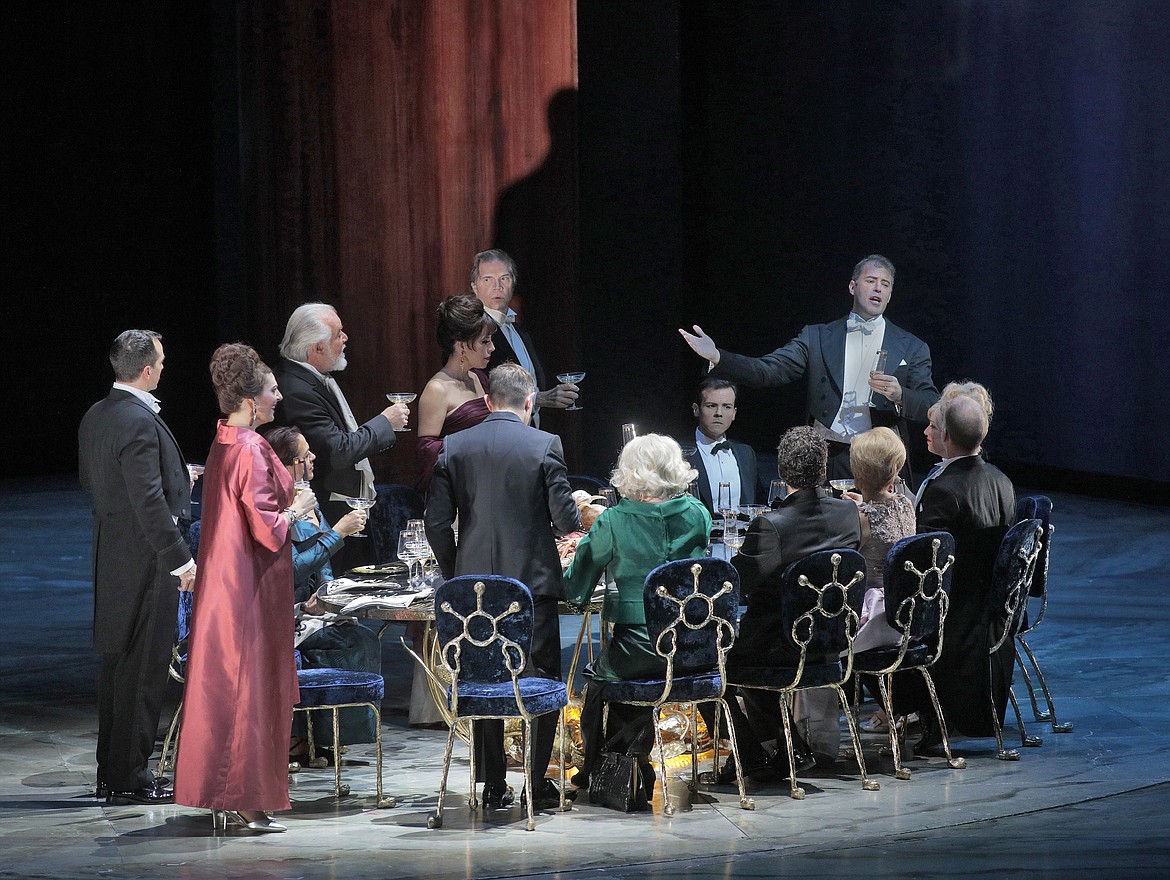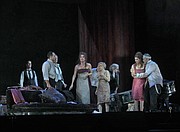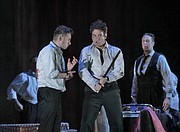'The Exterminating Angel'
The American premiere of Thomas Ades’ highly acclaimed new opera “The Exterminating Angel” will be shown at the Whitefish Performing Arts Center in Whitefish and Cinemark Signature Stadium 14 Theatres in Kalispell at 10:55 a.m. Saturday, Nov. 18.
It is sung in English with English subtitles; run time is 2 hours 40 minutes, which includes one intermission. Tickets for the Whitefish Performing Arts Center broadcast are available at the door for $20/adults, $5/students, $10/college students, cash or check. Tickets for the Signature Theatres broadcast are $23/adults, $21/seniors and $16/child.
Ever since “The Exterminating Angel” made its world debut in Salzburg in 2016, critics have been falling all over themselves to praise this brand-new work by composer Ades and librettist Tom Cairns. The New York Times says, “If you attend one Met opera this year, go to this stunningly inventive work ... the wild, searing score explores the emotional undercurrents of the story and emphasizes the horror ... the orchestra bristles with manic, almost madcap energy.”
Financial Times reported, “It is more than good; it is brilliant with utterly assured writing. It is clever, effective, dazzling, complex, yet awfully easy to listen to.”
“The Exterminating Angel” is based on a classic 1962 surrealist film of the same name by Spanish-born Mexican filmmaker Luis Bunuel. After attending an opera, an upper-class couple host a dinner party at their fancy apartment and invite the coloratura lead of the opera they just saw (Lucia di Lammermoor, by the way). Inexplicably, the guests discover they cannot leave the party, and as days go by, they descend into a state of panic and madness. The veneer of sophistication the guests arrived with slips away, and these once-elite individuals revert to the basest of human actions. Not to completely give away the storyline, let’s just say they do not all make it out.
This plot is understandably frightening in this era of heightened nuclear alert, terror attacks, horrible natural disasters and potential cyber and energy grid attack — all potential “exterminating angels” in their own right. But nothing physical is keeping these dinner party guests from walking out — no doors have been locked, for example — but nevertheless, some undetermined force keeps the guests inside the apartment. Perhaps the “exterminating angel” of this opera is merely a force that nullifies the guests’ will to act. Surreal, indeed.
The Bunuel film had no musical score, so what Ades composed for this opera is absolutely new and adds even more emotional impact to the plot. The orchestra is huge. We will hear a number of different musical references, ranging from Baroque, Viennese waltz, flamenco, mariachi trumpet, snippets of Wagner-esque-ness, and contemporary harmonies. We will also hear surrealistic sounds from miniature violins, xylophones, gongs, slamming doors, a gunshot, even someone playing a salad bowl. However, the orchestra’s surrealistic diva is the “ondes Martenot,” invented in 1928 by the French radio/telegraph operator Maurice Martenot. It is essentially an instrument that plays pitched radio waves with vibrato — ethereal, swooping sounds that evoke images of a higher power. Ades wrote the score for international ondes Martenot player, Cynthia Millar, who is playing it at the Met during this run.
Last summer I attended a performance of “Cosi fan tutte” at Central City Opera in Colorado. Afterwards, I waited in the garden patio outside the dressing room door for the cast to emerge and visited with baritone David Adam Moore who had just sung the lead role of Gugliemo. He mentioned that his next role would be Colonel Alvaro Gomez in the Met’s “The Exterminating Angel,” and I told him about my Live from the Met in HD articles. He graciously offered to send me some “insider information.”
Just a couple days ago on his way home on the subway from a performance, he typed out some thoughts on his phone and sent them to me. I want you to know who he is amid the cast of characters onstage: David Adam Moore plays a tall, dark, handsome military man — look for his pencil-thin mustache.
Moore wrote: “Fifteen lead characters in this show are locked in a room together, and therefore onstage the entire evening. As you can imagine, this presents quite a challenge for the stage director. Tom Cairns’ approach was to have us improvise each scene, then he would edit the stage like a film: setting key moments, then bringing them downstage into the “focal range” of the audience. Much of the background action you see during the show is still improvised during each performance, which keeps the cast on our toes.
“We begin the opera in a festive, classy party atmosphere and progress into a traumatic situation of physical survival. Much of the creative work we did as actors was to decide how our characters respond to starvation, fear and dramatically shifting power dynamics within the group.
“Ades’ harmonic language uses a kind of multi-layered tonality, which keeps the music lyrical and tuneful while still making use of dissonances. Most all of us found it fiendishly difficult to learn, but quite easy to retain and repeat once it is mentally locked in. A rare kind of time signature called an ‘irrational meter’ is prevalent in the score. It usually takes the form of a 2/6, 1/6, or 5/12 time signature. The sixth note is a quarter note triplet in relation to the established ‘rational’ meter — a preceding 4/4 bar, for example. The orchestra is massive, making use of every color and texture imaginable.”
The vocal writing in every role, including the shorter roles of the servants, is highly virtuosic and requires a fully developed vocal technique. For this reason, casting the show was difficult and expensive.
Librettist Cairns was indeed the stage director for this Met premiere, and Ades will conduct the Met orchestra. Therefore, they have ultimate control over the final product, and the performance will undoubtedly be just as they imagined it would be.
As David Adam Moore mentioned, “Thomas Ades is one of the best conductors I’ve worked with, charismatic and fully devoted to supporting us from the pit.”
Probably to better separate the characters for the audience, Ades wrote this opera for a very wide range of voice types. The highest is sung by the guest-of-honor opera singer played by coloratura Audrey Luna; she briefly sings the highest note reportedly ever sung on the Met stage: an A above high C. She claims that it is just “sung laughter” from offstage, but those notes are actually spelled out in the score. Luna says that occasionally when she sings that extraordinarily high note, she hears wax crackling in her ears. In contrast, a physician dinner guest is sung by veteran bass Sir John Tomlinson who can really hit the low notes. In between are the usual sopranos, mezzos, tenors, and baritones, with one unusual addition — a countertenor (a male who sings notes as high as a soprano). We will also hear mezzo Alice Coote singing a batty-woman female role, unusual for her because she almost always sings trouser roles.
“The Exterminating Angel” appears to be a perfect choice for an HD broadcast because the close-in camera work will probably help us more fully enjoy the opera. With 15 characters onstage at all times, the HD camerawork will focus our attention on the most important action at any one time.
Besides the Met debuting “The Exterminating Angel” this season, the 87-year old composer and lyricist Stephen Sondheim is currently composing a musical whose second act is clearly borrowed from Bunuel’s film “The Exterminating Angel.” Don’t be surprised if you hear about that version debuting on Broadway next season.
Sally Murdock is a guest writer for This Week in the Flathead and can be reached at murdock@cyberport.net.












